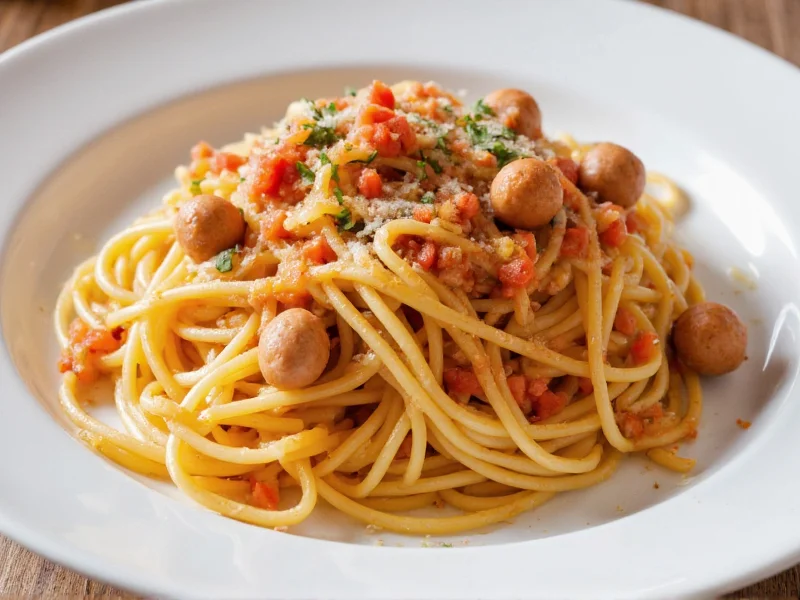The Essential Spaghetti with Sausage Recipe
Creating authentic spaghetti with sausage requires attention to ingredient quality and proper technique. Unlike basic pasta dishes, this recipe relies on the flavorful fat rendered from high-quality Italian sausage to build layers of taste in the sauce. The magic happens when you brown the sausage properly, creating fond (those delicious browned bits) that forms the flavor foundation.
Key Ingredients for Success
The difference between ordinary and extraordinary spaghetti with sausage lies in your ingredient selection. For the best homemade spaghetti with Italian sausage:
| Ingredient | Recommended Type | Why It Matters |
|---|---|---|
| Sausage | Sweet or spicy Italian (1 lb) | Fat content (20-30%) creates rich sauce base |
| Pasta | Spaghetti #5 or #7 (12 oz) | Thicker strands hold sauce better |
| Tomatoes | Canned San Marzano DOP (28 oz) | Balanced sweetness and acidity |
| Aromatics | Fresh garlic, onion, red pepper flakes | Builds complex flavor foundation |
Step-by-Step Cooking Process
Follow these professional techniques for perfect spaghetti with sausage every time:
- Brown the sausage properly: Remove casings and break into small chunks. Cook over medium-high heat without stirring for 3 minutes to develop crust, then stir occasionally until deeply browned (8-10 minutes total). Remove sausage, leaving 2 tablespoons of fat.
- Build the sauce foundation: Add 1 diced onion and cook until translucent (5 minutes). Add 4 minced garlic cloves and 1 teaspoon red pepper flakes, cooking until fragrant (1 minute). Deglaze with 1/2 cup dry red wine, scraping up browned bits.
- Simmer the sauce: Add crushed San Marzano tomatoes, 1 teaspoon dried oregano, and the browned sausage. Simmer uncovered for 15 minutes while pasta cooks, stirring occasionally.
- Cook pasta perfectly: Boil spaghetti in well-salted water until al dente (8-10 minutes). Reserve 1 cup pasta water before draining.
- Finish the dish: Toss drained pasta with sauce over medium heat, adding splashes of reserved pasta water until emulsified. Stir in 1/4 cup fresh basil and 2 tablespoons butter for silkiness.
Pro Tips for Restaurant-Quality Results
Master these techniques to elevate your quick weeknight spaghetti with sausage:
- Don't skip the fond: Those browned bits left in the pan after cooking sausage contain concentrated flavor. Proper deglazing incorporates them into your sauce.
- Reserve pasta water: The starchy water helps emulsify the sauce with the pasta, creating a restaurant-quality coating rather than a watery separation.
- Finish cooking in sauce: Never serve pasta with sauce on top. Tossing the cooked pasta in the sauce for 2-3 minutes allows it to absorb flavors and creates a unified dish.
- Balance acidity: If tomatoes taste too sharp, add a pinch of sugar or a small grated carrot during simmering to naturally balance acidity.
Popular Variations to Try
Once you've mastered the basic one-pot spaghetti with sausage, experiment with these authentic variations:
- Spaghetti with sausage and peppers: Add 1 diced bell pepper and 1/2 cup sliced olives during the last 5 minutes of sauce simmering for a New York-style classic.
- Creamy sausage spaghetti: Stir in 1/2 cup heavy cream and 1/2 cup grated Parmesan during the final toss for a richer version.
- Healthy spaghetti with turkey sausage: Substitute ground turkey seasoned with fennel, garlic powder, and red pepper flakes for a lighter option (add 1 tbsp olive oil to compensate for less fat).
- Spicy arrabbiata style: Double the red pepper flakes and add 1/4 cup chopped fresh parsley for a fiery Roman variation.
Serving and Storage Guidelines
For optimal enjoyment of your spaghetti with sausage:
- Serving: Plate immediately with additional grated Pecorino Romano (not just Parmesan), fresh basil, and a drizzle of high-quality olive oil. Pair with a simple green salad and crusty bread.
- Storage: Cool completely before transferring to airtight containers. Properly stored spaghetti with sausage keeps for 3-4 days in the refrigerator.
- Reheating: Add 1-2 tablespoons water or broth when reheating in a skillet over medium-low heat, stirring gently until warmed through. Avoid microwaving, which makes pasta gummy.
Common Questions Answered
Can I make spaghetti with sausage ahead of time?
Yes, but with proper technique. Cook the sauce separately and store it apart from the cooked pasta. Reheat the sauce, then toss with freshly cooked al dente spaghetti. Pre-tossed pasta becomes mushy when reheated due to continued starch absorption.
What's the best sausage for spaghetti with sausage?
High-quality Italian sausage with 20-30% fat content works best. Look for sausage made with pork shoulder, fennel seed, garlic, and either sweet (mild) or hot (spicy) red pepper flakes. Avoid preshredded sausage or varieties with excessive fillers like breadcrumbs.
Why does my spaghetti with sausage turn out watery?
Watery sauce typically happens when you don't reduce the tomatoes sufficiently or add too much pasta water. Simmer your sauce uncovered for at least 15 minutes to concentrate flavors, and add reserved pasta water gradually (1-2 tablespoons at a time) until you achieve a silky coating consistency.
Can I use fresh tomatoes instead of canned for spaghetti with sausage?
While possible, canned San Marzano tomatoes are preferred for consistent flavor and texture year-round. If using fresh, select ripe plum tomatoes, roast them at 375°F for 20 minutes, then blend and simmer to reduce excess liquid. Fresh tomatoes contain more water and less concentrated flavor than quality canned varieties.
How do I prevent my spaghetti from sticking together?
Prevent sticking by using plenty of well-salted water (4-6 quarts per pound of pasta), stirring immediately after adding pasta, and never adding oil to the cooking water. Reserve pasta water before draining, and toss the pasta with sauce immediately while both are hot for proper coating.











 浙公网安备
33010002000092号
浙公网安备
33010002000092号 浙B2-20120091-4
浙B2-20120091-4